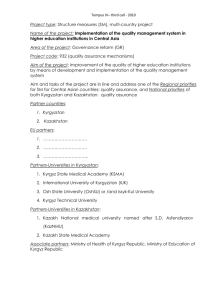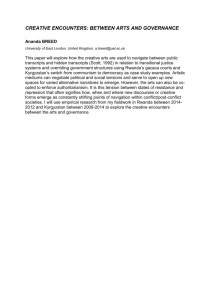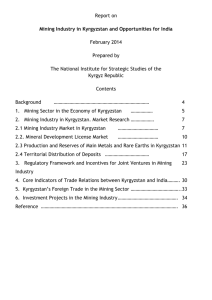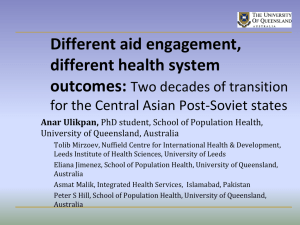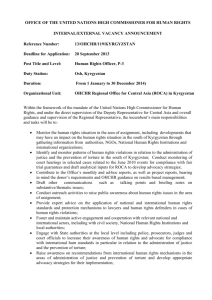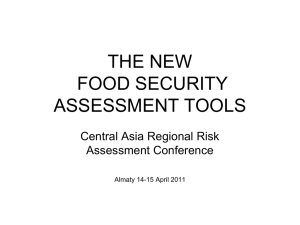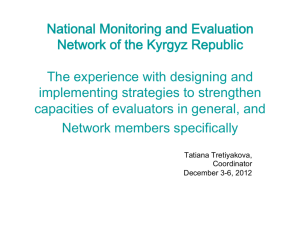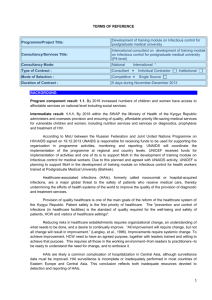The Future of Kyrgyzstan
advertisement
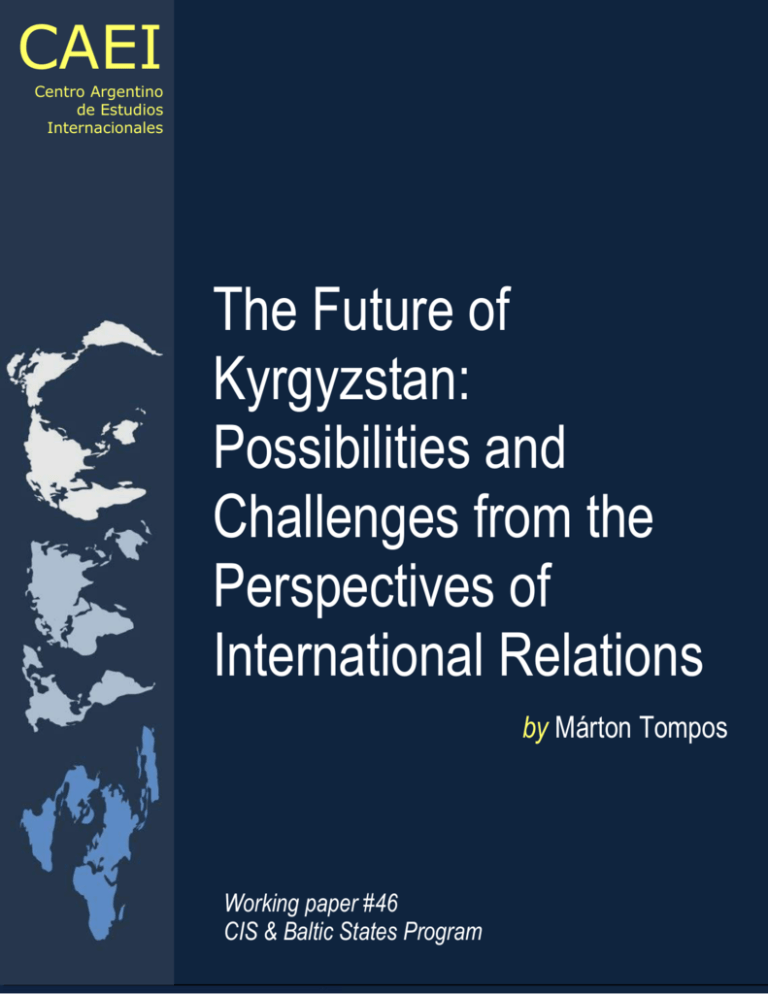
CAEI Centro Argentino de Estudios Internacionales The Future of Kyrgyzstan: Possibilities and Challenges from the Perspectives of International Relations by Márton Tompos Working paper #46 CIS & Baltic States Program 1 Todos los derechos reservados. - Pág. 1 The Future of Kyrgyzstan: Possibilities and Callenges from the Perspectives of International Relations By Márton Tompos Bachelor of Arts in History and Religious Studies from the Eötvös Loránd University, Budapest, Hungary. Researcher for the CIS & Baltic States Program since 2011. / CAEI Introduction Kyrgyzstan’s international affairs have two aspects: on one hand, bordering China, the traditionally present Russia and the always interested USA are competing with each other for the better partnership with the Kyrgyz government. On the other hand, neighboring Kazakhstan, Uzbekistan and Tajikistan are all showing different faces to Kyrgyzstan, challenging and helping Bishkek at the same time. Despite the lack of considerable amount of natural resources in the country, Kyrgyzstan, thanks to its location, is still a crucial target for all three superpowers. The United States is already present in the country, operating the Manas airbase next to Bishkek. For the supply of its troops in Afghanistan the future of the base is a cardinal question for Washington, however the opportunity to monitor neighboring China and the troubled Fergana Valley also increases the stake for the USA. To secure the stability of its own territories and provide space for enormous future projects, such as the railway between Xinjiang and London, China uses its economic power and the long common border to develop its position, causing hard times for local companies, but also reducing the prices on the market which is highly welcomed by consumers. Finally, there is the Russian interest which is based on history and tradition besides the struggle against the US and its plan the encircle Moscow’s territories. Kyrgyzstan’s relations to its three neighboring Central Asian countries are highly diversified. On one hand there is Kazakhstan with its huge investments in the country, the immediate financial aid they gave to Bishkek after the events of April 2010 and the extremely friendly tone, the two 2 Todos los derechos reservados. - Pág. 2 countries’ politicians talk with and about each other. On the other hand, there is Uzbekistan as – from Kyrgyz perspective – the opposite of Kazakhstan; Tashkent and Bishkek continuously argue over the gas prices, the clashes of last year were claimed as Kyrgyzstan’s inner state affairs by Uzbek President Islam Karimov and the situation of the Uzbek minority in Kyrgyzstan generates a continuous tension between the two. Somewhere in the middle can be found the troubled Tajikistan; smuggling and some terrorist cells’ movement between the borders overshadow the basically friendly relations of the countries. All in all, it seems that the the fastest way of development for Kyrgyzstan is to balance between the three major powers, however slowly getting closer to Russia, while on a regional level, try to work on a Central Asian Union, which would help solving the territory’s problems and balance the Russian influence. Geopolitics China Kyrgyzstan’s inner peace and stability is a crucial question for China, both from the economic and security perspective. First of all, the volume of trade between the two countries radically increased in the previous years: from 604 million $ in 2004 it reached 1.54 billion $ by 2006 and 2.97 billion $ by 20091. Although recent violent events2 in the Central-Asian country radically decreased this amount, there is no evidence suggesting that this figure will not return or even exceed its previous level. Also, the meeting between Kyrgyz President Almazbek Atambayev, Ismail Tiliwaldi, 1 Umed Erkinov, „Kyrgyzstan: Is China the Hidden Power in Bishkek?,” Eurasianet, http://www.eurasianet.org/departments/insightb/articles/eav031809.shtml, March 17, 2009. 2 The successful demonstrations against President Bakiyev in April 21010 claimed the life of more than 80 people only in Bishkek and several more as the clashes spread around the whole country. 3 Todos los derechos reservados. - Pág. 3 vice chairman of the Standing Committee of China’s National People’s Congress and a special envoy of Chinese President Hu Jintao on 2nd of December, 20113 – the same day when Atambayev was sworn in as President – clarifies that the importance of China has not changed with the regime in Bishkek. However, the appearance of “Made in China” goods did not cause general satisfaction; as the report of the French Institute of International Relations says; "The effect on the Kyrgyz economy of this massive trade is both positive and negative. It creates jobs and people have access to cheap, good quality projects. However, the local production finds itself unable to compete"4. Besides the increased competition on the Kyrgyz market, the following Chinese immigration also leads to tension as the country already suffers from an 11%5 high unemployment rate and an increasing number of – mainly educated – Kyrgyz searching for work abroad6. However, Kyrgyzstan’s importance is higher to China from geopolitical perspectives than by its 5.5 million-people-market. The ambiguous plan of Beijing is the railway connection between Xinjiang and the port of Gwadar in Pakistan – where 60 % of China’s Middle Eastern oil import goes through – via Kyrgyzstan, Tajikistan, Afghanistan and Pakistan obviously requires the inner peace of all of these countries7. There is also another grandiose plan from the far eastern superpower which might need the cooperation of Bishkek; the railway between Xinjiang and Germany, and by 2025, London. This may run through Kazakhstan, not Kyrgyzstan, but as it is still just a plan, Beijing definitely wants to have as many options open as possible. 3 http://www.chinadaily.com.cn/china/2011-12/02/content_14205259.htm, December 2, 2011. Erkinov. 5 http://www.indexmundi.com/kyrgyzstan/unemployment_rate.html 6 “Emigration from Kyrgyzstan is surging,” Eurasianet, http://www.eurasianet.org/departments/civilsociety/articles/eav032106.shtml, March 20, 2006. 7 Roman Muzalevsky, “The Economic Underpinnings of China’s Regional Security Strategy in Afghanistan,” The Jamestown Foundation, http://www.jamestown.org/single/?no_cache=1&tx_ttnews%5bswords%5d=8fd5893941d69d0be3f37857626 1ae3e&tx_ttnews%5bany_of_the_words%5d=afghanistan&tx_ttnews%5btt_news%5d=36285&tx_ttnews%5 bbackPid%5d=7&cHash=436692a068, April 19, 2010. 4 4 Todos los derechos reservados. - Pág. 4 Last but not least, as Kyrgyzstan is neighboring the problematic Xingjiang Autonomous Region where ethnic clashes occurred in previous years between Uyghur people and Han Chinese, an instable state next door is the last thing what China needs. A possible hideout for extremist Muslim groups, next to the rebelling Uyghur – also Sunni Muslim – territories could be a great threat to China’s inner security. Furthermore, the presence of the U.S. army in Kyrgyzstan especially with the cooperation of the Kyrgyz leadership to monitor Chinese activities in Xinjiang, are far from being welcomed by Beijing. In the meantime “a sizeable Uighur community lives in Kyrgyzstan and almost 100,000 ethnic Kyrgyz live in Xinjiang. This facilitates the flow of information and the organization of other activities”8, such as scouting activities by the American intelligence. On the whole, China’s main advantage is its common border with Kyrgyzstan, which simplifies trade and strengthens the relations of the two countries. Despite that it may cause some dissatisfaction among the Kyrgyz traders, Chinese goods reduce prices and can become an increasing part of the Kyrgyz state’s revenues. However, the United States and Russia also have some serious interest in the Central Asian country, therefore their offers and requests also have to be taken into consideration before choosing a future “best friend” for the Kyrgyz. The United States When referring to the USA, the first thing that needs to be mentioned is the Manas Air Base. It was opened in December 2001 to support the coalition’s movements in the war in Afghanistan, though as it has been described before, the Chinese actions also can be monitored from here. The reason, why it is crucial for the United States to maintain Manas is the vulnerability of the other 8 K. Gajendra Singh, „Geoppolitical Battle in Kyrgyzstan over US military Lilypond in central Asia,” Media with Conscience, http://mwcnews.net/focus/analysis/1810-geopolitical-battle-in-kyrgyzstan-over-us-militarylilypond-in-central-asia.html, April 12, 2010. 5 Todos los derechos reservados. - Pág. 5 supply routes. The way via Pakistan, more precisely, via the port of Karachi where the containers are off-loaded onto trucks, is extremely dangerous and “Because of Pakistani sensitivities about sovereignty, these trucks are 100 percent civilian-operated, with no military escorts.”9 The alternative routes are the part of the NDN (Northern Distribution Network); the NDN North and the NDN South both go via Kazakhstan and Uzbekistan, while the KKT goes through Kyrgyzstan and Tajikistan; in all three instances by using the local U.S. military bases. All three NDN routes reach the Afghan border at Termiz, Uzbekistan, however most of the supply and the troops from Manas are being transferred to Afghanistan by air carriage. A relevant problem is the issue of the Fergana Valley. Spreading across the territories of Uzbekistan, Kyrgyzstan and Tajikistan and presumably the home of Muslim fundamentalist, the U.S., as a part of the “war on terror”, is committed to monitor the local activities in the Valley. However “many in the Shanghai Cooperation Organization10 region suspect that the NDN will be used by the Pentagon to encourage spread attacks by groups like the ‘Islamic Movement of Uzbekistan’ or the ‘Islamic Jihad Union’ and the murky Hizb ut-Tahrir movement”11. Whether this is true or not, it is now official that the US will pay an annual 200 million $12 for the usage of Manas. However no one knows whether this will disappear as it did during the presidency of Bakiyev, who “placed his son and other relatives in key posts where they raked in huge sums for the US airbase rights at Manas – reportedly as much as $80 million a year”13 or now, with Atambayev, it will reach the people. Also it is problematic whether the U.S. can maintain its military presence in the region and – as K. Gajendra 9 Bill Marmon, „New Supply ’Fron’ for Afghan War Runs Across Russia, Georgia and the ’Stans,” The European Institute http://www.europeaninstitute.org/February-%E2%80%93-March-2010/new-supply-frontfor-afghan-war-runs-across-russia-georgia-and-the-stans.html, February – March, 2010 10 An intergovernmental mutual-security organization founded in Shanghai in 2001. The members are China, Kazakhstan, Kyrgyzstan, Russia, Uzbekistan and Tajikistan. Observer states are India, Iran, Mongolia and Pakistan. 11 Cornelius Graubner, “Implications of the Northern Distribution Network in Central Asia,” Central Asia – Caucasus Institute, http://www.cacianalyst.org/?q=node/5169, January 9, 2009. 12 http://www.tazar.kg/news.php?i=5230, July 14, 2007. 13 F. William Engdahl, “Kyrgyzstan as a Geopolitical Pivot in Great Power Rivalries,” Centre for Research of Globalization, http://www.globalresearch.ca/index.php?context=va&aid=19327, May 25, 2010. 6 Todos los derechos reservados. - Pág. 6 Singh, retired ambassador of India in Turkey, Azerbaijan and several other countries sees it – continue the “Western intrusion into eastern and even central Eurasian lands.” As the interest of Washington is mainly coming from its political and military ambitions, it is questionable if the United States can be the best choice as the main partner of the country. Even if the money after Manas reaches the people and a short-term pivot position can be beneficial, a war – irrespective of whether it is in Afghanistan or anywhere else – is always temporary, while the presence of China and Russia is constant. Nevertheless, the people also want another friend; according to a Gallup survey from July 2008, 63% of the respondents said, that a close relationship with Russia, even if it might hurt relationships with the USA is more important14. Russia Russia’s interest in Kyrgyzstan comes from several factors. First of all, since the Great Game of the nineteenth century, when Britain and the Tsar’s empire fought their political war for the control over the territory, the whole region was under Russian influence. From Bishkek’s point of view, this war was won by the Russians as they captured the city in 1862 and by the early 1880’s the whole territory of today’s Kyrgyzstan belonged to Tsar; hence they were under Russian control for around 110 years. Besides this, 9 % of the country’s population is Russian 15, which means approximately half million people. However, from a geopolitical perspective, Moscow’s main interest comes from two other sources; drug traffic and inner security. As Semyon Bagdasarov, deputy of the Russian State Duma described in an interview in August, 2010; 14 15 http://gmj.gallup.com/content/150011/kyrgyzstan-security-freedom-later.aspx http://www.joshuaproject.net/countries.php?rog3=KG 7 Todos los derechos reservados. - Pág. 7 “In October 2009, the United Nations stated, in a very professional and comprehensive report, absolutely clearly that at the time US troops went to Afghanistan, no drugs were cultivated in the Taliban-controlled areas. An absolute record in this respect, 8,200 tons [of opium], was set in 2007 after the US troops had arrived in Afghanistan.…in that report Mr. [Luiz Carlos da] Costa, the deputy special representative of the United Nations’ Secretary General who is also the head of the UN Office on Drugs and Crime, said that drugs were not the biggest problem. Can you imagine it, given the fact that 30,000 or 40,000 Russians were annually dying of drug abuse.”16 In other words, the Taliban, that forbade commerce of drugs on their territories, had to find a fast and highly profitable source with the arrival of the NATO troops. As one of the main routes of narcotics to Europe leads through Russia, the presence of the coalition’s forces in Afghanistan – at least from this point of view – causes some discontent in Moscow, even if the country gains profit from letting the Americans and their allies use their infrastructure to transport their supply. This results in the question, whether Russia should put some pressure on the Kyrgyz leadership to close down the Manas base and try to work on the end of the Afghan war or use the money coming from NATO, to fight more efficiently against drug trafficking – and usage as well – among the Russian borders. Even though, since 2003 Russia has its own airbase at Kant next Bishkek, the issue of inner security enforces the former; as F. William Egdahl, journalist and contributor of the Centre for Research on Globalization put it, “the Medvedev-Putin regime is creatively using every level -- from energy pipeline deals with the state-owned Gazprom, to military trade -- to rollback the threatening NATO encirclement that reached its peak in 2004-2005 with Washington’s ‘Color Revolutions’ in Georgia, Ukraine and finally Kyrgyzstan”17. At the moment the solution is somewhere in the middle as the joining of Georgia and Ukraine to NATO is now off the table; the Russians use the upcoming end of the Manas’ contract to put some conditions in the new one; they want the Americans to practice better control over drug trafficking. 16 http://rt.com/usa/news/us-central-asia-chaos/ F. William Engdahl, “Kyrgyzstan’s ‘Roza Revolution’: Russia and the Future of Kyrgyzstan,” Centre for Research of Globalization, http://www.globalresearch.ca/index.php?context=va&aid=19335, June 4, 2010. 17 8 Todos los derechos reservados. - Pág. 8 Getting back to the traditional influence of Moscow over the territory, three organizations need to be mentioned. First of all, Kyrgyzstan is already a member of the SCO and the CSTO18. Secondly, according to Atambayev – at this time he was the First Deputy Prime Minister of the interim government – Kyrgyzstan wants to join the Customs Union of Belarus, Russia and Kazakhstan; "We have a common past with Kazakhstan and Russia and obviously our future will be with them in a common economic space and a common customs space". Talking about the common past, the will of politicians and people seem to meet each other at this point; in a 2010 Gallup survey 65 % of Kyrgyz respondents wanted “a strong authoritarian system, which places order above freedom”; “a system that has a lot of similarity to the Soviet one, but more democratic and market-based” or “the Soviet system which was in place in your country prior to Perestroika”19. All in all, Moscow’s interest – besides its traditional influence and their own people there – is mainly the result of the American’s activities in the region. The continuing effort to get a closer relation with the Central Asian country – Russia was the first to recognize the interim government after the coup in April 2010 – suggests that Russia has long-term intentions, while the U.S., as it has been analyzed previously, not necessarily capable of maintain its own presence in the region. In sum Kyrgyzstan seems to be in a good position to use the rivaling parties against each other, however balancing between two superpowers has never been an easy task, not to mention that in this case there are three of them. Therefore perhaps the most efficient solution is to use the money of the U.S. and the investments of China to stabilize and develop the country, while step-bystep getting closer to Russia. This would somehow reflect the will of the people and by maintaining the relations with the former two, the influence of Moscow could also be hold on a healthy level. 18 An intergovernmental military alliance which was signed on 15 May 1992. The members are Armenia, Belarus, Kazakhstan, Kyrgyzstan, Russia, Tajikistan and Uzbekistan. 19 http://gmj.gallup.com/content/150011/kyrgyzstan-security-freedom-later.aspx 9 Todos los derechos reservados. - Pág. 9 The Neighbors Kazakhstan From economic perspective Kazakhstan’s influence in Kyrgyzstan is unquestionable. In 2007 the two countries’ Prime Ministers established a common investment found with a total of 120 million $. Kazakhstan’s part was 100 million $, which demonstrates how seriously Astana considers the investment in its developing neighbor. Also “Kazakhstan’s major cities are becoming more attractive for Kyrgyz migrant workers, including businessmen and highly skilled workers.… At the same time, more and more residents of southern Kazakhstan are traveling to Kyrgyzstan for tourism and various services today, as prices are much lower in Kyrgyz cities.”20 Furthermore, the expressed importance of the vast northern neighbor did not change with the system in Bishkek; in an interview in January, 2011, the interim government’s President, Roza Otunbayeva praised her Kazakh colleague, Nursultan Nazarbayev and his country for supplying building materials of 10 million $ 21 in order to reconstruct Kyrgyzstan’s southern regions. Also, in February 2011, on a meeting in Astana, Prime Minister Atambayev and President Nazarbayev agreed on further expansion of the bilateral economic partnership. The fact, that “There are more than 400 companies in banking, energy, gas transportation, manufacturing, and the production of building materials operating in Kyrgyzstan with the Kazakh investments in them, along with 250 companies with the Kyrgyz participation operating in Kazakhstan”22 shows that both countries are willing to strengthen their cooperation. 20 Erica Marat, “Kazakh-Kyrgyz Economic Relations Receive New Boost”, The Jamestown Foundation, http://www.jamestown.org/single/?no_cache=1&tx_ttnews%5Btt_news%5D=32864, July 12, 2010. 21 http://www.inform.kz/eng/article/2346321, January 31, 2011. “A bi-weekly online publication of the Ministry of Foreign Affairs of the Republic of Kazakhstan”, February 08, 2011. 22 10 Todos los derechos reservados. - Pág. 10 Uzbekistan Regarding the Uzbeks and the problems between the two countries, two historical elements need to be clarified. First of all, the Kyrgyz were ruled by the Uzbek Kokand Khanate from 1710 until 1876, and lost four wars against them between 1845 and 1873 23. Secondly, Kyrgyz are traditionally shepherding nomads, while Uzbeks are sedentary farmers and due to the differences of the two ways of life, the Uzbeks were always wealthier. Relating to these or not, it is certain that the main cause of the tension between the two countries is the Uzbek minority in Kyrgyzstan, with a total population of close to 800.000 people. The most well-known issues were the clashes in the city and region of Osh in 1990 and 2010. The former caused the death of 120 Uzbeks, 50 Kyrgyz and one Russian 24, while in last year’s event officially 893 people lost their lives25, however unofficial figures talk about more than 2000 killed26. Additionally, the differences between the two countries’ system also lessens the chances of cooperation. As Erica Manat – analyst and reporter at Voice of America's Russian Service – described it; “Boosting ties with Uzbekistan could potentially affect the democratic climate in Kyrgyzstan. Bishkek risks cooperating with an authoritarian political regime that seeks to persecute its own political dissidents on neighboring territories….Kyrgyzstan has become a hub for numerous Uzbek political asylum-seekers, refugees, and members of banned religious groups, mainly from eastern Uzbek cities.27” 23 http://www.centralasia-biz.com/cabiz/eng/kyrgyz_eng/tourist_kg_eng/tourism_hystory_kg_eng.htm Valery Tishkov, "Don't Kill Me, I'm a Kyrgyz!': An Anthropological Analysis of Violence in the Osh Ethnic Conflict," Journal of Peace Research, Vol. 32, No. 2. pp. 134–5. 25 http://rt.com/news/kyrgyzstan-riots-death-toll/, June 12, 2010. 26 http://www.polit.ru/news/2010/06/12/1000/, June 12, 2010. 27 Erica Marat, “Kyrgyz-Uzbek Security Relations: Similar Problems, Different Policies,” The Jamestown Foundation, http://www.jamestown.org/single/?no_cache=1&tx_ttnews%5Btt_news%5D=31929, August 1, 2006. 24 11 Todos los derechos reservados. - Pág. 11 Kyrgyzstan’s dependence on Uzbek gas is another element of the tension between the two post-Soviet countries. In 2005 Tashkent’s unilateral closure of the tap, forcing Kyrgyzstan to buy from Kazakhstan on a higher price level, while in this year a 14 % increase in the price showed to Bishkek that the neighbors are not afraid to use their natural resources as a tool. Tajikistan The third Central Asian country bordering Kyrgyzstan, Tajikistan has its own problems. Drug trafficking from Afghanistan and Islamist militants means a constant threat to the country’s stability and in 2009, the International Crisis Group stated that the country is close to become a failed state28. However, Tajikistan seems to work on these issues as they reported to gain full control over their problematic eastern regions29, also in the name of cooperation they handed over two suspected terrorists to Uzbekistan and Kyrgyzstan. For Bishkek, both problems are relevant; drug trafficking results in pressure from Russia, while infiltration of extremists groups can challenge the country’s inner security. As it has been described by The Jamestown Foundation’s analysts, Roger Kangas and Brianne Todd “until the ethnic violence that occurred in southern Kyrgyzstan in June, Tajikistan’s relationship with Kyrgyzstan was relatively positive.…However, as the killings in Osh and Jalalabad were taking place in midJune, Kyrgyz officials and media offered oblique comments that the actual culprits were gangs of “provocateurs” coming across the border from Tajikistan”30. The similarities of the two countries are 28 http://www.crisisgroup.org/~/media/Files/asia/centralasia/tajikistan/162_tajikistan___on_the_road_to_failure.ashx, February 12, 2009. 29 http://www.bbc.co.uk/news/world-asia-pacific-11565443, October 18, 2010. 30 Roger Kangas, Brianne Todd, “Arrests Mark Opportunity for Improved Relations Between Tajikistan and its Neighbors,” The Jamestown Foundation, http://www.jamestown.org/single/?no_cache=1&tx_ttnews%5Btt_news%5D=36711, August 5, 2010. 12 Todos los derechos reservados. - Pág. 12 obvious; they both host NATO forces31, they are “both dependent upon Kazakhstan and Uzbekistan for their hydrocarbon energy, while also providing water to the same countries32”, they both face problems of internal stability and they both try to develop the economic relations of the two countries33. On the whole, all three countries have a different approach towards Kyrgyzstan; Kazakhstan, at the moment playing the role of the helping bigger brother, Uzbekistan, aggressively using their gas supply and is concerned about the mistreat of its people and troubled Tajikistan having issues between its own borders which need to be solved, before it could seriously step out to the international stage. One of the possible solutions could be a Central Asian Union, which was proposed by President Nazabayev in 200734. It would contain all five Central Asian countries and besides it could counter-balance the power of CSTO and SCO it could also help to find solutions to ethnic and security problems in the region. Despite the considerable difference between the origin and the lifestyles of the peoples, in a well-organized Union the benefits would exceed the disadvantages. Conclusion To sum up, Kyrgyzstan faces tough competition for its support. China is using its economic power to gain influence, the USA is already present with the Manas base and wants to keep it this way, while Russia is working on the opposite, to get the Americans out of the country and the region. This competition is a heavy burden, but in good hands, it can be beneficial for the country. The best 31 The Franch Air Force has a base in Tajikistan since 2002. Kangas, Brianne. 33 http://www.universalnewswires.com/centralasia/tajikistan/viewstory.aspx?id=10052, August 26, 2011. 34 http://www.towardsunity.org/cau.phtml 32 13 Todos los derechos reservados. - Pág. 13 option – and the most supported by the public, as well – would be Russia, however the progress towards Moscow needs to be slow and without seriously damaging the interests of the other two. On regional level, Kazakhstan seems to be a serious investor, while with Tajikistan, after it solves its own internal issues, the high number of similarities can help the future cooperation. Uzbekistan’s high importance is unquestionable, first of all due to its gas supply, however the various historical differences and events, also the issue of the Uzbek minority in Kyrgyzstan, makes collaboration difficult. A Central Asian Union could help on both balancing the increased influence of Russia and solving the regional problems, however it is still a very long-term project. But the region and Kyrgyzstan have time and as it is not so likely that the major powers’ interest drop soon, they have various opportunities as well. It is only up on them, to determine how they will use it. Bibliography - Engdahl, F. William, “Kyrgyzstan as a Geopolitical Pivot in Great Power Rivalries,” Centre for Research of Globalization, http://www.globalresearch.ca/index.php?context=va&aid=19327, May 25, 2010. - Engdahl, F. William, “Kyrgyzstan’s ‘Roza Revolution’: Russia and the Future of Kyrgyzstan,” Centre for Research of Globalization, http://www.globalresearch.ca/index.php?context=va&aid=19335, June 4, 2010. - Erkinov, Umed, „Kyrgyzstan: Is China the Hidden Power in Bishkek?,” Eurasianet, http://www.eurasianet.org/departments/insightb/articles/eav031809.shtml, March 17, 2009. - Graubner, Cornelius, “Implications of the Northern Distribution Network in Central Asia,” Central Asia – Caucasus Institute, http://www.cacianalyst.org/?q=node/5169, January 9, 2009. - Kangas, Roger; Todd, Brianne, “Arrests Mark Opportunity for Improved Relations Between Tajikistan and its Neighbors,” The Jamestown Foundation, http://www.jamestown.org/single/?no_cache=1&tx_ttnews%5Btt_news%5D=36711, August 5, 2010. 14 Todos los derechos reservados. - Pág. 14 - Marat, Erica, “Kyrgyz-Uzbek Security Relations: Similar Problems, Different Policies,” The Jamestown Foundation, http://www.jamestown.org/single/?no_cache=1&tx_ttnews%5Btt_news%5D=31929, August 1, 2006. - Marat, Erica, “Kazakh-Kyrgyz Economic Relations Receive New Boost”, The Jamestown Foundation, http://www.jamestown.org/single/?no_cache=1&tx_ttnews%5Btt_news%5D=32864, July 12, 2010. - Marmon, Bill, „New Supply ’Fron’ for Afghan War Runs Across Russia, Georgia and the ’Stans,” The European Institute http://www.europeaninstitute.org/February%E2%80%93-March-2010/new-supply-front-for-afghan-war-runs-across-russia-georgiaand-the-stans.html, February – March, 2010 - Muzalevsky, Roman, “The Economic Underpinnings of China’s Regional Security Strategy in Afghanistan,” The Jamestown Foundation, http://www.jamestown.org/single/?no_cache=1&tx_ttnews%5bswords%5d=8fd5893941d 69d0be3f378576261ae3e&tx_ttnews%5bany_of_the_words%5d=afghanistan&tx_ttnews %5btt_news%5d=36285&tx_ttnews%5bbackPid%5d=7&cHash=436692a068, April 19, 2010. - Singh, K. Gajendra, „Geoppolitical Battle in Kyrgyzstan over US military Lilypond in central Asia,” Media with Conscience, http://mwcnews.net/focus/analysis/1810geopolitical-battle-in-kyrgyzstan-over-us-military-lilypond-in-central-asia.html, April 12, 2010. - Tishkov, Valery, "Don't Kill Me, I'm a Kyrgyz!': An Anthropological Analysis of Violence in the Osh Ethnic Conflict," Journal of Peace Research, Vol. 32, No. 2. pp. 134–5. - “A bi-weekly online publication of the Ministry of Foreign Affairs of the Republic of Kazakhstan”, February 08, 2011. - “Emigration from Kyrgyzstan is surging,” Eurasianet, http://www.eurasianet.org/departments/civilsociety/articles/eav032106.shtml, March 20, 2006. - http://www.bbc.co.uk/news/world-asia-pacific-11565443, October 18, 2010. - http://www.centralasiabiz.com/cabiz/eng/kyrgyz_eng/tourist_kg_eng/tourism_hystory_kg_eng.htm - http://www.crisisgroup.org/~/media/Files/asia/centralasia/tajikistan/162_tajikistan___on_the_road_to_failure.ashx, February 12, 2009. 15 Todos los derechos reservados. - Pág. 15 - http://gmj.gallup.com/content/150011/kyrgyzstan-security-freedom-later.aspx October 20, 2011. - http://www.indexmundi.com/kyrgyzstan/unemployment_rate.html - http://www.inform.kz/eng/article/2346321, January 31, 2011. - http://www.jamestown.org/single/?no_cache=1&tx_ttnews%5Btt_news%5D=36711, August 5, 2010. - http://www.joshuaproject.net/countries.php?rog3=KG - http://www.polit.ru/news/2010/06/12/1000/, June 12, 2010. - http://rt.com/news/kyrgyzstan-riots-death-toll/, June 12, 2010. - http://rt.com/usa/news/us-central-asia-chaos/ - http://www.tazar.kg/news.php?i=5230, July 14, 2007. - http://www.towardsunity.org/cau.phtml - http://www.universalnewswires.com/centralasia/tajikistan/viewstory.aspx?id=10052, August 26, 2011. 16 Todos los derechos reservados. - Pág. 16
